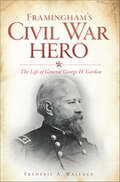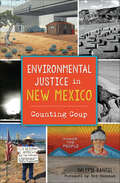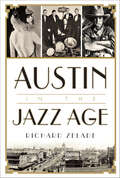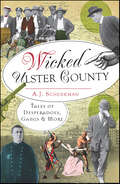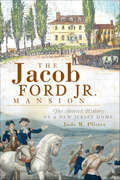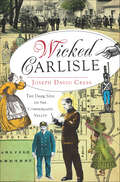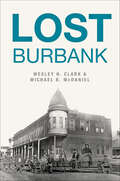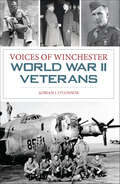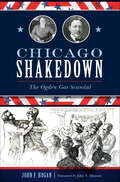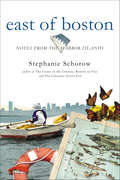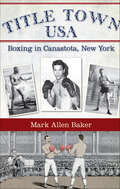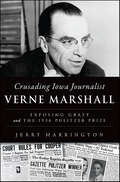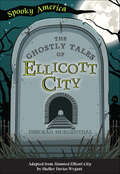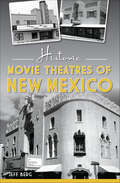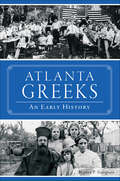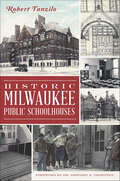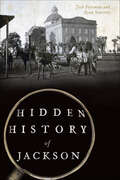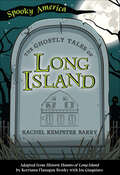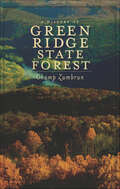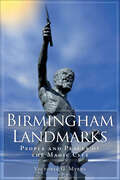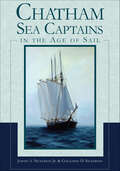- Table View
- List View
Framingham's Civil War Hero: The Life of General George H. Gordon (Civil War Series)
by Frederic A. WallaceGeorge Henry Gordon, who moved to Framingham, Massachusetts, at the age of five, attended the U.S. Military Academy at West Point, where his attitudes toward the country were shaped alongside classmates George McClellan, Thomas �Stonewall� Jackson and Ulysses S. Grant. Gordon went on to hold political and military offices in the North, and as a general in the Union army, he led his troops against Jackson in the Valley Campaign, at Antietam and at the Siege of Charleston. Join historian Frederic A. Wallace as he recounts the largely untold story of General George H. Gordon, Framingham�s favorite son, with personal diary entries and letters that reveal a man of integrity and honor whose actions displayed an outright love for his country.
Environmental Justice in New Mexico: Counting Coup (Natural History)
by Valerie RangelIn New Mexico and across America, communities of color bear the brunt of contamination from generations of expansion, mining, nuclear testing and illegal dumping. The nation's largest uranium waste spill occurred in 1979 at Church Rock, and radioactivity in the Rio Puerco remains at dangerous levels. The National Trust for Historic Preservation listed Mount Taylor as one of the ten most endangered historic sites in America. After decades of sickness from Rio Grande river water, the first female governor of a Pueblo Nation, Verna Olgin Teller, led tribal members to a Supreme Court victory over Albuquerque. Valerie Rangel presents stories of strife and struggle in the war to protect the integrity of natural systems, rights to religious freedom and the continuation of traditional customs.
Austin in the Jazz Age
by Richard ZeladeThough renowned, Austin's contemporary music scene pales in comparison with the explosion of creative talent the city spawned during the Jazz Age. Dozens of musicians who started out in the capital city attained national and international fame--but music was just one form of artistic expression that marked that time of upheaval. World War I's death and destruction bred a vehement rejection of the status quo. In its place, an enthusiastic adherence to life lived without question or consequence took root. The sentiment found fertile soil in Austin, with the University of Texas at the epicenter. Students indulged in the debauchery that typified the era, scandalizing Austin and Texas at large as they introduced a freewheeling, individualistic attitude that now defines the city. Join author Richard Zelade in a raucous investigation of the day and its most outstanding and outlandish characters.
Shockoe Hill Cemetery: A Richmond Landmark History (Landmarks)
by Alyson L. Taylor-WhiteEstablished in 1822, Shockoe Hill Cemetery is the final resting place for many famous and infamous icons of Richmond. Most visited is the tomb of Chief Justice John Marshall, the longest-serving chief justice of the United States, who elevated the Supreme Court to equal standing with the executive and legislative branches of the federal government. Union spy Elizabeth Van Lew operated an extensive espionage ring during the Civil War, and though reviled in life by many who resented her activism, she rests prominently near her elite neighbors. The burial places of friends and foster family offer a glimpse into Edgar Allan Poe's personal story. Author Alyson Lindsey Taylor-White charts the history of the celebrated cemetery and brings to life the stories of those buried there.
Wicked Ulster County: Tales of Desperadoes, Gangs & More (Wicked)
by A.J. SchenkmanUncover Ulster County's hidden history of unsavory characters and stories of its wicked past.Situated in the scenic Hudson Valley, Ulster County is a lovely location to make a home and raise a family, but it wasn't always so pleasant. Unsavory characters and immoral events have sullied its name. In the 1870s, the Shawangunk Mountains inspired fear rather than awe, as groups like the Lyman Freer and Shawangunk gangs robbed and terrorized locals, descending from the protection of the wooded peaks. Kingston was torched, arson blazed in Kerhonkson and even the Mohonk Mountain House was threatened by flames. In 1909, the Ashokan Slasher's bloody crimes and sensational trial captured headlines across the country. Discover these and other salacious stories buried in Ulster County's history.
The Jacob Ford Jr. Mansion: The Storied History of a New Jersey Home (Landmarks)
by Jude M. PfisterIn 1772, the Ford family began building what would easily become the largest home in Morristown and years laterbecame the site of the first National Historic Park in the United States. Completed just before colonial unrest reached a boilingpoint, the home quickly secured a reputation as a place of prominence for supporters of colonial interests. Today, the mansion is best known as George Washington's headquarters,when it became a strategic site for Washington during a winter encampment and gained importance for its role in the American Revolution. Jude Pfister tells the story of this beloved home that has endured the tests of time and whose own history is inextricably woven into that of the country's.
Wicked Carlisle: The Dark Side of the Cumberland Valley (Wicked)
by Joseph David CressWith Wicked Carlisle, author Joe Cress revisits the criminal history of Cumberland County. Taking a more focused and less bloody approach, Cress will largely bring new stories of mischief to the table, though he will revisit the lighter side of two or three crimes from Murder and Mayhem in Cumberland County. From stories of college pranks gone wrong, Carlisle's own Robin Hood and the robbing and subsequent torching of a beloved local theater (the Strand where the local HS now sits ) to abuses at the Carlisle Indian School and the town's connection to the raid on Harper's Ferry, Cress scours the underbelly of the borough for mischief and misdeeds.
Forgotten Chicago Airfields
by Nicholas C. SeligNick Selig excavates the highways to the sky that have been covered up by urban sprawl or dissolved by neglect. More than a guide to landing strips that have had startling second lives as shopping malls or retirement homes, he uncovers the excitement of the early days of air travel, when a man might cling to his job as a lavatory truck driver for a closer peek at aviation. In this follow-up to "Lost Airports of Chicago," discover how a tractor swap gave birth to Clow International Airport and revel in the daredevil exploits of puddle-jumper pilots over the wide-open spaces of Harlem Avenue.
Lost Burbank (Lost)
by Wesley H. Clark Michael B. McDanielSlowly fading with the city's ever-changing landscape, the places and people of Burbank's past tell a vibrant story. Before the arrival of Warner Bros. and Walt Disney, First National Pictures built its original studio lot on Olive Avenue in 1926. For over sixty years, Lockheed Aircraft Company produced some of the nation's best airplanes where the massive Empire Shopping Center now stands. Heavyweight champion James Jeffries turned his Burbank ranch home and barn into a beloved landmark and boxing venue. And inventor Joseph Wesley Fawkes's scheme to build a monorail to Los Angeles became a local laughingstock. Die-hard Burbankers Wes Clark and Michael McDaniel collect these and many more forgotten local stories where they can finally be found.
Voices of Winchester World War II Veterans (American Chronicles)
by Adrian J. O'ConnorStories of the Greatest Generation come alive in the hands of longtime local journalist Adrian O'Connor What made the D-Day attack on Omaha Beach so remarkable was that it was carried out largely out by National Guardsman - men of the 29th Infantry Division who had never before seen combat. One of the companies that was part of this historic day hailed from the environs of Winchester, Virginia. Winchester's martial gallantry was hardly restricted to the beaches of Normandy, though. A future city councilor came ashore at Anzio, Italy. A future school principal fought in what may have been the Pacific's toughest battle, Iwo Jima. Local men held the line at the climactic Battle of the Bulge, flew over Europe and the oil fields of Ploesti and even escaped a German prisoner-of-war camp.
Chicago Shakedown: The Ogden Gas Scandal
by John F. HoganThe Ogden Gas Affair represented the biggest political scandal of Chicago's first sixty years. Mayor John P. Hopkins and Democratic Party boss Roger Sullivan conspired with ten other insiders to form a dummy corporation to blackmail Peoples Gas Company. The scam poured money into the coffers of beneficiaries who were never prosecuted, including the governor of Illinois, John P. Altgeld. As their lengthy swindle ran its course, Hopkins and Sullivan rubbed elbows with the most notorious grafters of the robber baron era, including Charles Yerkes and "Big Bill" Thompson. Author John Hogan follows the money in a scheme that became a template for the enrichment of the connected at the expense of the citizenry.
East of Boston: Notes from the Harbor Islands
by Stephanie SchorowFor the traveler who might not have a yacht�just a sense ofhumor and a spirit of adventure�Stephanie Schorow proves you can still embark on a voyage through the Boston Harbor Islands. A practical guide, complete with camping tips and driving directions, East of Boston�s droll travelogue takes the measure of these gloriously wild Edens all within sight of the city�s skyline. Join Schorow around a campfire for some friendly conversation about pirate treasure, elusive foxes, cross-dressing ghosts, flying Santas and a strange era of spontaneously combusting garbage dumps. And if you are truly brave, perhaps take a sip of the park ranger�s �Sumac-ade.�
Title Town USA: Boxing in Canastota, New York
by Mark Allen BakerCanastota, New York, at the epicenter of Upstate New York's rich boxing heritage, is home to the International Boxing Hall of Fame. Having produced some of boxing's most prominent pugilists, including Carmen Basilio and Billy Backus, the area has also hosted many legendary fighters, including Jack Britton, Harry Greb, Sam Langford and Tommy Ryan. Many boxing dreams have come true here through title fights and epic ring rivalries. Author Mark Allen Baker tells the story of those "thunder gods of the ring" and the fights that made them famous, finally settling the score: Canastota is "Title Town, USA."
Crusading Iowa Journalist Verne Marshall: Exposing Graft and the 1936 Pulitzer Prize
by Jerry HarringtonOn December 12, 1934, police raided a canning factory in Cedar Rapids, uncovering an illegal liquor and gambling set-up. Verne Marshall, tempestuous editor of the Cedar Rapids Gazette, sensed a bigger story and a wider network of corruption. His aggressive investigative reporting led to multiple resignations, nearly fifty indictments and the dramatic trial of the state's attorney general. These explosive exposés earned Verne Marshall and the paper the 1936 Pulitzer Prize. Author Jerry Harrington traces the legacy of Marshall's incendiary crusade across Iowa's political landscape.
The Ghostly Tales of Ellicott City (Spooky America)
by Deborah MorgenthalGhost stories from Ellicott City, Maryland have never been so creepy, fun, and full of mystery! The haunted history of Ellicott City comes to life—even when the main players are dead. Visit the Third Ellicott City Firehouse and catch a glimpse of the people who died in the tragic fire that occurred there. Or step inside the ruins of Patapsco Female Institute, and be sure to keep an eye out for the ghoulish girls that may be running around! Dive into this spooky chapter book for suspenseful tales of bumps in the night, paranormal investigations, and the unexplained; just be sure to keep the light on.
Historic Movie Theatres of New Mexico (Landmarks)
by Jeff BergNew Mexico's theatrical ties span over one hundred years. The Fountain Theatre, once a Civil War hospital and headquarters, produced plays, opera and vaudeville performances until 1929, when the venue started airing talkies. Today, it holds the title of oldest operating theatre in New Mexico. Albuquerque drive-in attendees enjoyed personal screens for each car at the Circle Autoscope. And Rio Grande Theater operated for over seventy years before showing its final screening of U.S. Marshals in 1998. Author Jeff Berg details the Land of Enchantment's iconic movie houses.
Kentucky's Civilian Conservation Corps (Vintage Images)
by Connie M. HuddlestonBy the time Franklin D. Roosevelt took his first oath of office,the Great Depression had virtually gutted the nation�s agricultural heartland. In Kentucky, nearly one out of every four men wasunemployed and relegated to a life of poverty, and as quickly as the economy deflated, so too did morality. �The overwhelming majority of unemployed Americans, who are now walking the streets�would infinitely prefer to work,� FDR stated in his 1933 appeal to Congress. So began the New Deal and, with it, a glimmer of hope and enrichment for a lost generation of young men.From 1933 up to the doorstep of World War II, the Civilian Conservation Corps employed some 2.5 million men acrossthe country, with nearly 90,000 enrolled in Kentucky. Native Kentuckian and CCC scholar Connie Huddleston chronicles their story with this collection of unforgettable and astonishing photographs that take you to the front lines of the makeshift camps and through the treacherous landscape, adversity, and toil. The handiwork of the Kentucky �forest army� stretches from Mammoth Cave to the Cumberlands, and their legacy is now preserved within these pages.
Atlanta Greeks: An Early History (American Heritage Ser.)
by Stephen P. GeorgesonBy 1890, the first Greek immigrants to Atlanta had settled into an area still widely populated by Confederate veterans. In a city without the large immigrant presence common in the nation's major urban areas, the Greeks were initially received as undesirable visitors by the state's and city's leaders. While the Greek Orthodox Church of Atlanta endured financial hardship, it continued to aid funerals, hospitals and orphanages. These Greeks moved from the city's streets as fruit vendors into more established businesses. Christ Gyfteas's fruit stand at the corner of Broad and Marietta became the California Fruit Company. By 1911, 40 percent of Greeks were proprietors or partners in a variety of businesses like cafés, restaurants, soda fountains and groceries. Author Stephen Georgeson explores the Greek immigrants' experiences in their first three decades in Atlanta.
Historic Milwaukee Public Schoolhouses (Landmarks)
by Robert TanziloIt's no surprise we feel a connection to our schools, where we learn to read, write and forge social bonds of all kinds. They are potentially the scenes of our first crushes (and the second and third). They are where we learn to create ourselves. For more than a century, Milwaukee has taken its schoolhouses seriously, and it has a matchless variety of gorgeous landmarks to prove it. Robert Tanzilo pays homage to some long-lost schools, salutes some veteran survivors and examines the roles they play in their neighborhoods. Learn a little about some remarkable Milwaukee architects and see what the future may hold for some of the city's most beloved old buildings.
Hidden History of Jackson (Hidden History)
by Josh Foreman Ryan StarrettThe history of Jackson is filled with gripping tales of horrors and heroism. Join Ryan Starrett and Josh Foreman as they reveal the hidden past of the City with Soul.A recording company founded in the mid-1960s with the expectation of competing with New Orleans and Memphis was a national success, outlasting its better-funded rivals. Known as the "Devil's Backbone," the Natchez Trace is the graveyard for countless travelers slain by the road's numerous serial killers, brigands and land pirates. Yet one mass grave stands above the others: the Boyd Mounds, which hold the remains of thirty-one Choctaws. Although legend has it that the father of Jackson, Louis LeFleur, was a Canadian trapper famous in high society for his dancing, the truth is even stranger.
The Ghostly Tales of Long Island (Spooky America)
by Rachel Kempster BarryGhost stories from New York State's famous island have never been so creepy, fun, and full of mystery!Long Island's haunted history and local legends come to life--even when the main players are dead. Do ghosts lurk in the famed OHEKA Castle? Do the spies of the American Revolution's Culper Ring still haunt Setauket? Are the colonists at the Old Bethpage Village Restoration historians--or ghosts? Dive into this spooky chapter book for suspenseful tales of bumps in the night, paranormal investigations, and the unexplained; just be sure to keep the light on.
A History of Green Ridge State Forest
by Champ ZumbrunJoin former forest manager Champ Zumbrun as he traverses hidden trails to tell the remarkable story of Green Ridge State Forest.Green Ridge State Forest is a haven of calm and natural beauty among the Appalachians of western Maryland. This land was once the frontier of the nation, and trailblazers such as Thomas Cresap and George Washington were among the first Europeans to discover its wonders: the swift Potomac, the flowering dogwood and pine in the mountain reaches and the nighttime calls of the bobcat and the barred owl. The vision and stewardship of people like forester Fred W. Besley preserved the forest for future generations of hikers, explorers and families. Join former forest manager Champ Zumbrun as he traverses hidden trails to tell the remarkable story of Green Ridge State Forest.
Lost Rochester, Minnesota (Lost)
by Amy Jo HahnRochester is synonymous with one of its most famous landmarks, the Mayo Clinic, but there's so much more to the Med City. It began as a frontier town, struggling to make its mark in a sparsely populated wilderness. By the late nineteenth century, Rochester had expanded into a vibrant city, rich with business, educational and cultural opportunities. Rediscover the Dubuque Trail and the beautiful summer lake retreats, along with the Cook Hotel, the Central Fire Station and more. Author Amy Jo Hahn uncovers the lost beginnings of Rochester and brings the stories of this unique place to life.
Birmingham Landmarks: People and Places of the Magic City (Landmarks)
by Victoria MyersThough the landscape has certainly changed, many of Birmingham�s early landmarks�testaments to the steelworkers who built the city after the Civil War, as well as those who have since prospered here�remain. In Birmingham Landmarks, Alabama native Victoria Myers explores the Magic City�s most prominent industrial and cultural features. Step back in time to discover Rickwood Field, one of America�s oldest baseball parks, and the Carver Theater, the only venue that allowed African Americans to view first-run movies before the civil rights movement. Find out why Birmingham is known as the Pittsburgh of the South at Sloss Furnaces and learn the secrets of Vulcan, who was commissioned for the 1904 World�s Fair and has become one of the state�s most recognizable monuments.
Chatham Sea Captains in the Age of Sail
by Geraldine D. Nickerson Joseph A. Nickerson Jr.Chatham Sea Captains in the Age of Sail chronicles the lives and adventures of twenty-five men who traveled the seas from the eighteenth through the twentieth century. These were extraordinary men�masters of navigation who charted paths from the Cape to the Far East with their regal clipper ships; deep-sea fishermen whose fearless spirit drove them to the Grand Banks and Newfoundland in the quest for their catch; and coastal captains who skirted America�s eastern seaboard in pursuit of trade. Spurred on by the Industrial Revolution�s demands, these mariners continued their pelagic exploration while pirates, privateers and Confederate raiders tested their mettle. The sea was both foe and ally. To meet the foe was the challenge; to sail her waters and return home as true masters was the force that drove these men to excellence.
